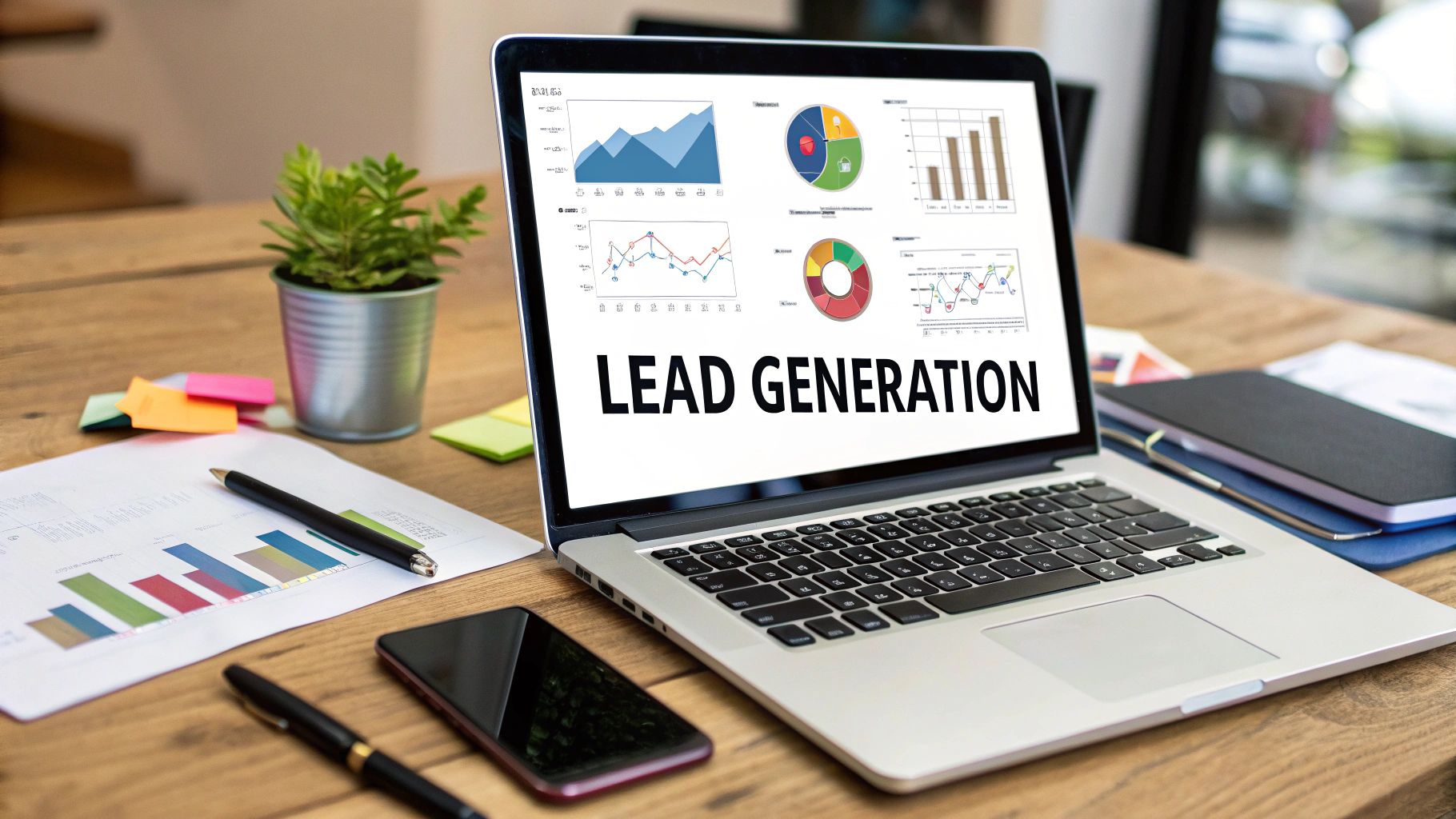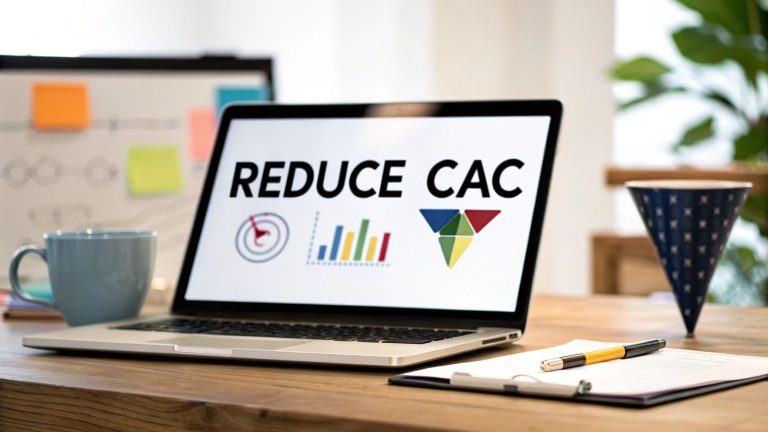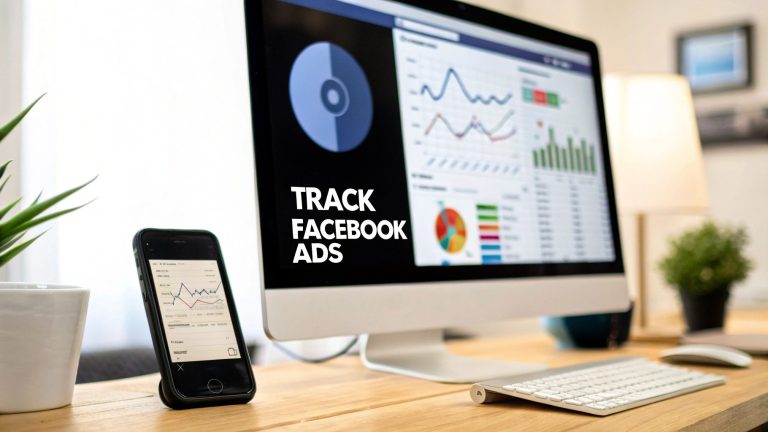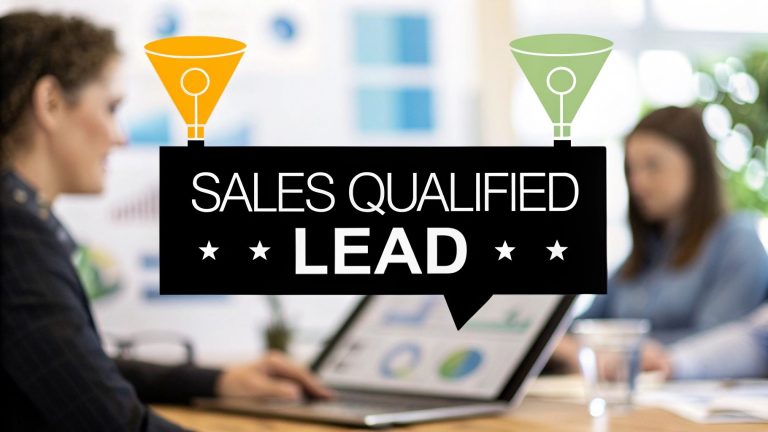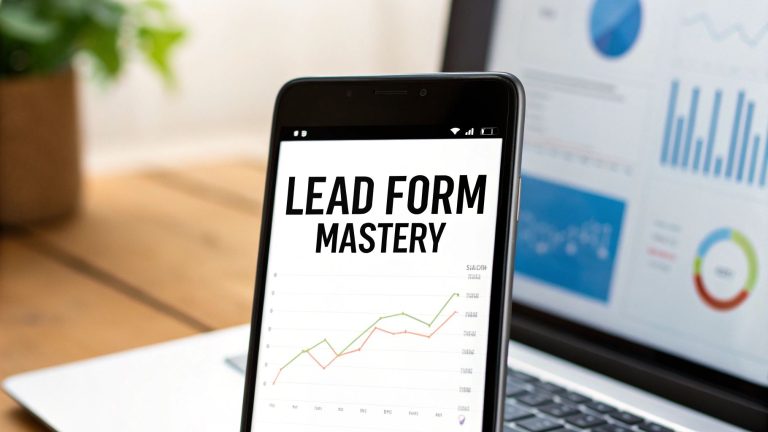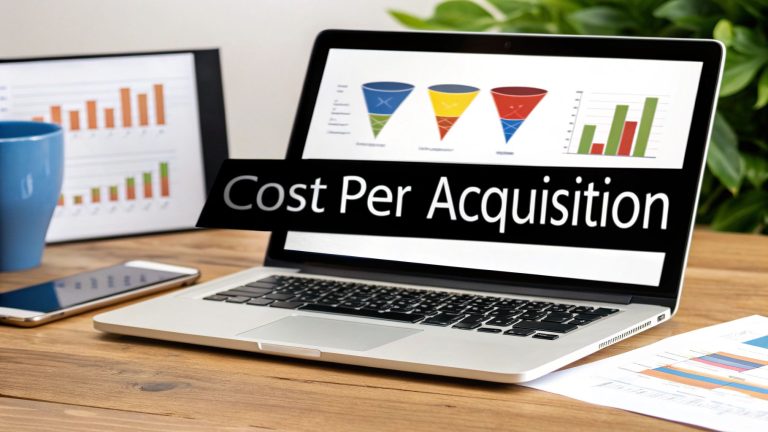Lead Generation for Marketing Agency: Boost Your Client Base
For any marketing agency, leads are the lifeblood. It's not just about getting any business to notice you; it's about systematically attracting and converting the right businesses into long-term, paying clients. This is the core of lead generation: filling your sales pipeline with high-quality prospects who are genuinely looking for the exact marketing magic you create.
Building Your Agency's Lead Generation Foundation
Before you even think about launching a campaign, you have to pour the concrete. A winning lead generation strategy doesn't start with a clever ad or a cold email blast. It begins with a rock-solid understanding of who you serve and, just as importantly, why they should give you their time and money.
This foundational work is what separates the agencies that consistently land dream clients from those that are always scrambling for the next project. It's about getting granular with your targeting and messaging, moving past guesswork, and letting data drive your decisions.
Define Your Ideal Client Profile
This is where so many agencies get it wrong. They try to be the solution for everyone, and in doing so, they become the perfect solution for no one. To build a predictable, steady stream of leads, you absolutely must define your Ideal Client Profile (ICP) with laser-like precision.
An ICP isn't just a vague description; it's a detailed blueprint of your perfect client. Go way beyond the basics like industry and company size. You need to dig deeper:
- Budgetary Realities: What do they typically spend on marketing? Can they actually afford your retainers, or are you just wasting your time?
- Decision-Making Structure: Who signs the checks? Is it a marketing director with autonomy, a committee, or the CEO themself? Knowing this changes your entire approach.
- Operational Maturity: Are you talking to a sophisticated e-commerce brand with an in-house team or a local business owner wearing all the hats? Their needs—and their ability to appreciate your work—are worlds apart.
- Specific Pain Points: What specific problems are keeping them up at night? Are they bleeding money on ads that don't convert, invisible on Google, or getting zero engagement on social media?
Think of a well-defined ICP as your agency's bouncer. It ensures you only spend your precious time and resources on prospects who are a perfect fit, which will send your conversion rates through the roof.
This is why getting it right from the start is so critical. The numbers don't lie.
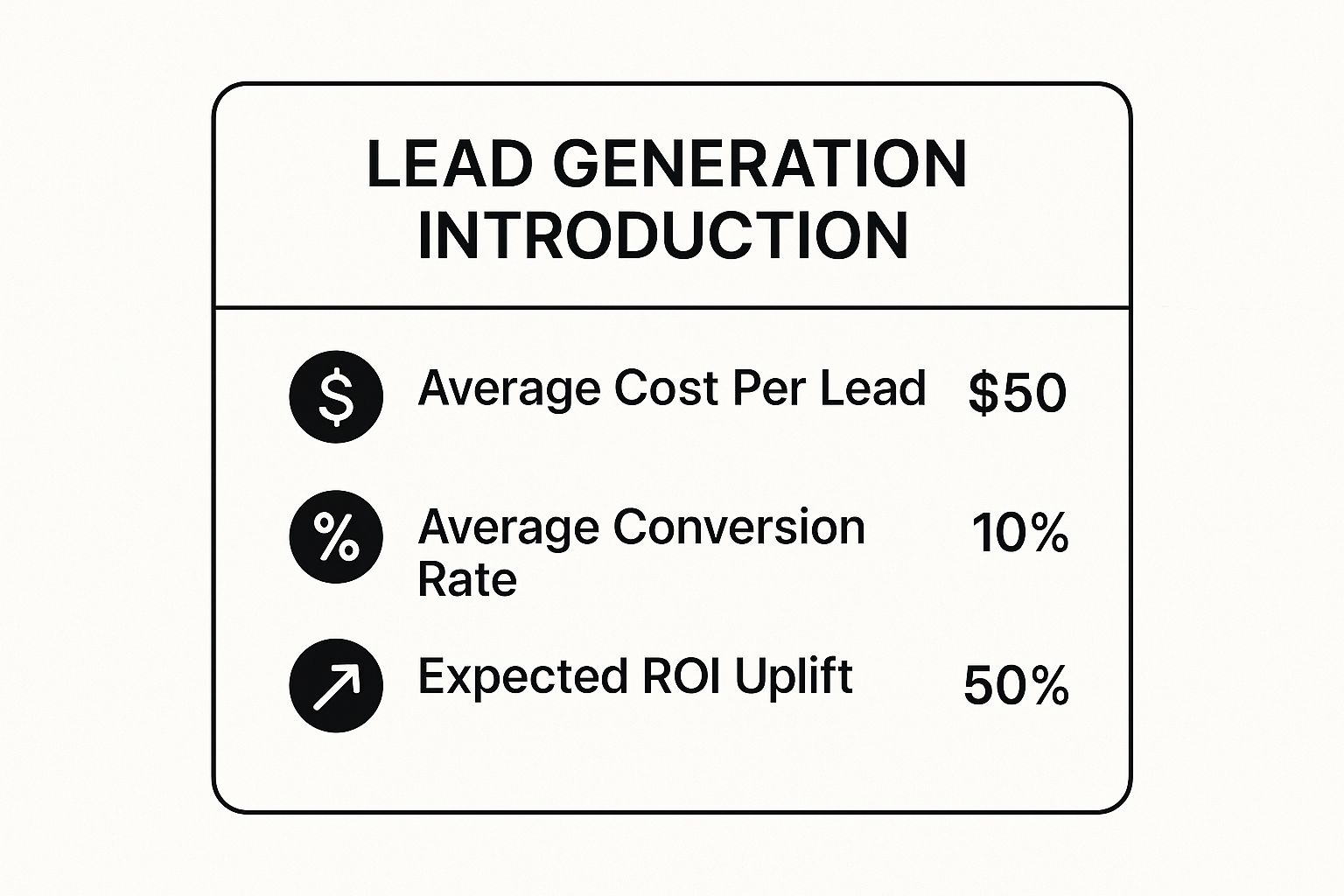
As you can see, leads come at a serious cost. Targeting the right audience from the get-go isn't just good practice; it's essential for your bottom line.
Craft a Compelling Value Proposition
Okay, so you know who you're talking to. Now you have to give them a reason to listen. Your value proposition is a short, sharp statement that screams the unique, tangible benefit you deliver. It has to immediately answer the prospect's unspoken question: "What's in it for me?"
This isn't just some fluffy slogan you stick on your homepage. It's the core of every email, ad, and sales call. A killer value proposition speaks directly to the pain points of your ICP and positions your agency as the only logical solution. Honing this message is one of the most powerful strategies for agencies to skyrocket their sales funnel through lead generation.
The agency world is only getting more crowded. By 2025, a full 50% of marketers are pointing to lead generation as their top challenge. And while the average organization might pull in around 1,877 leads a month, each one of those comes with a hefty price tag—an average of $198.44. That's a lot of cash to burn if your messaging isn't on point.
To put these strategies into perspective, here's a quick look at the most reliable channels agencies are using right now.
Core Lead Generation Channels for Agencies
This table breaks down the most effective channels, what they're best for, and how to measure success.
| Channel | Primary Use Case | Key Success Metric |
|---|---|---|
| SEO & Content Marketing | Attracting high-intent prospects searching for solutions you provide. | Organic traffic, keyword rankings, inbound form submissions. |
| Paid Advertising (PPC) | Generating immediate, targeted leads based on specific demographics and behaviors. | Cost Per Lead (CPL), Conversion Rate, Return on Ad Spend (ROAS). |
| Cold Outreach | Directly targeting your ICP with personalized email or LinkedIn messages. | Reply Rate, Meeting Booked Rate. |
| Referrals & Partnerships | Leveraging existing client relationships and professional networks for warm introductions. | Number of qualified referrals, Client Lifetime Value (CLV). |
Each channel has its place, but they all depend on the foundational work of defining your ICP and nailing your value proposition. Get that right, and you're already ahead of the game.
Mastering Inbound Marketing for Consistent Leads
If you want sustainable growth for your agency, you need an inbound marketing engine that works for you 24/7. This isn't just about tossing up a blog post now and then. It's about building an authority platform that consistently pulls in qualified prospects who are already searching for the exact solutions you offer.
The goal? To become the indispensable resource in your industry.

When you get this right, you create a powerful, self-sustaining loop. You publish valuable content that climbs the search rankings, which brings in visitors. Those visitors become leads, and eventually, those leads turn into clients who become your biggest fans.
Building Your Content Authority
The foundation of any killer inbound strategy is pillar content. I’m talking about substantial, deep-dive pieces that cover a core topic inside and out, specifically for your ideal clients. Think of it as your "ultimate guide," a piece of proprietary research, or a massively detailed case study.
This kind of content does more than just bring in traffic; it builds serious trust and cements your agency's reputation as a thought leader. Instead of a quick 500-word article, create a resource so valuable that other industry blogs can't help but link to it. That's how you boost your domain authority and climb the organic rankings for the long haul.
This whole approach is central to effective lead generation for a marketing agency because it flips the script from quantity to quality. A single, well-executed pillar page can generate far more qualified leads than a dozen shallow blog posts ever could.
SEO Tactics Tailored for Agencies
Of course, for your pillar content to do its job, people have to find it. This is where you get surgical with your SEO. Your dream clients aren't just Googling generic terms; they're looking for specific solutions to their problems.
You need to target long-tail keywords that signal a prospect is getting close to a buying decision. So, instead of going after a broad term like "digital marketing," zero in on the exact phrases your ideal customer profile (ICP) would use:
- "B2B SaaS content marketing agency"
- "e-commerce PPC management services"
- "local SEO for multi-location businesses"
By aligning your content with these solution-focused searches, you attract visitors who are not just browsing but actively seeking the services you provide. This significantly shortens the sales cycle and improves lead quality.
This strategy ensures you're not just getting traffic, but the right traffic. It all starts with the basics, and if you want a refresher, our guide on what is lead generation in marketing breaks down the core principles.
The Anatomy of Compelling Lead Magnets
Okay, you've got traffic coming to your site. Now what? You need a way to turn those anonymous visitors into actual, tangible leads. This is where lead magnets shine. A lead magnet is simply a valuable resource you offer for free in exchange for an email address and other contact info.
But to really work, your lead magnet has to be irresistible to your ideal client. Generic eBooks are tired and often ignored. Instead, create practical tools that solve a specific, nagging problem for them.
Try offering one of these high-value assets:
- An ROI Calculator: Let prospects plug in their numbers and see the potential return from hiring you.
- A Website Audit Checklist: Give them a downloadable checklist to self-diagnose SEO or conversion issues on their site.
- An Exclusive Webinar Recording: Offer on-demand access to a deep-dive presentation on a topic they care about.
When you create a content ecosystem that builds trust and a conversion path that captures their interest, you start filling your pipeline organically and consistently. No more chasing cold leads.
Outbound Strategies That Actually Work
Let’s be honest, inbound marketing is great for the long game, but sometimes you just need to fill the pipeline now. This is where outbound comes in. Unfortunately, outbound marketing often gets a bad rap, usually because people associate it with spammy, generic messages flooding their inboxes.
But when you approach it with a little intelligence and a lot of personalization, outbound becomes a seriously powerful tool. It’s how you get in front of high-value decision-makers who might never stumble across your blog on their own. The trick is to stop thinking about mass blasting and start thinking about strategic, value-first outreach.
Every single interaction is a chance to solve a problem, not just to pitch your services.
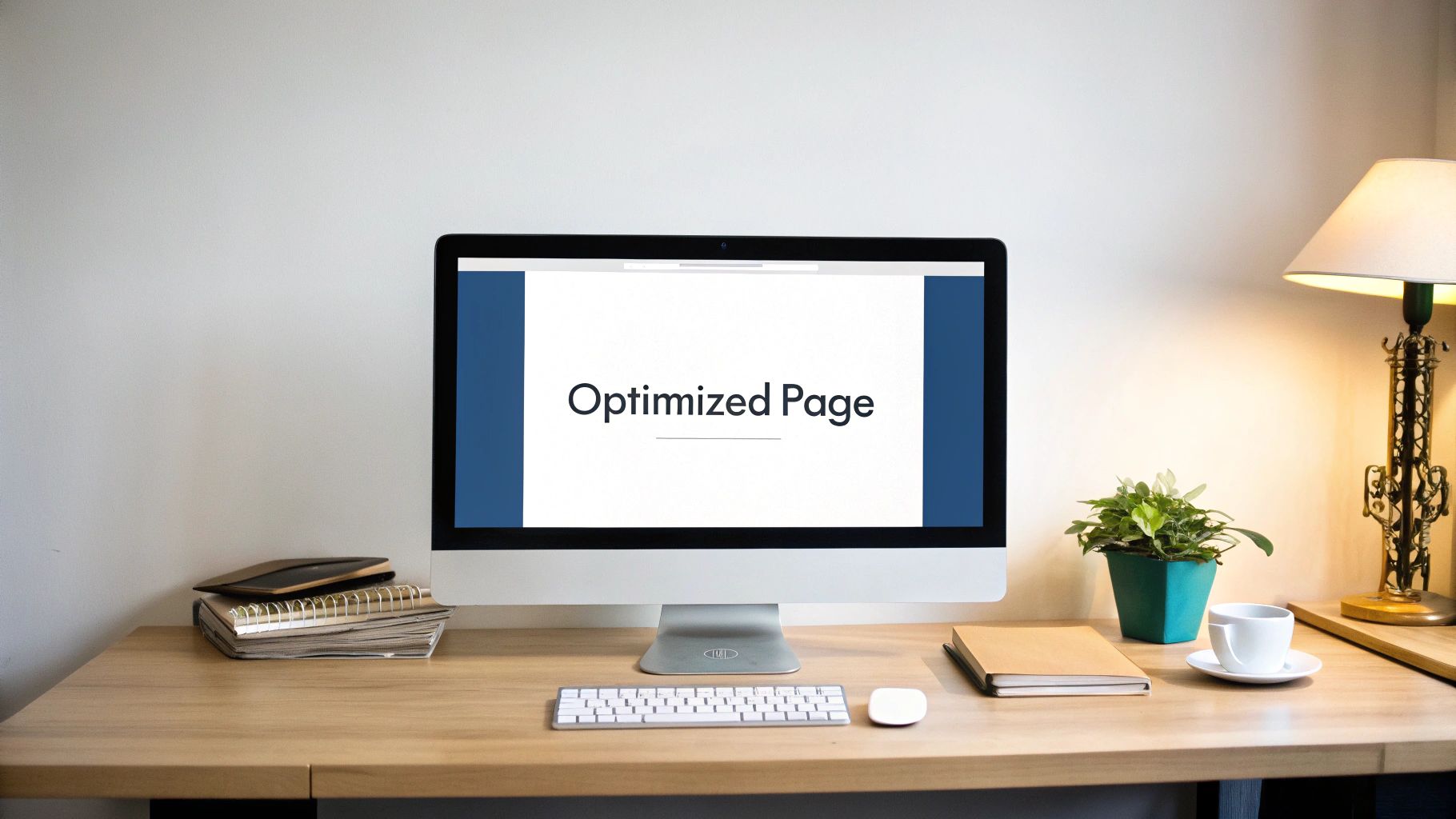
LinkedIn: More Than Just a Rolodex
LinkedIn isn't just for posting your resume anymore—it’s the undisputed king of B2B networking and lead generation. As of 2025, it has solidified its spot as the go-to channel for high-quality B2B leads, with a whopping 40% of marketers calling it their number one source. The real magic of LinkedIn is its precision targeting and the ability to build genuine connections before you ever ask for a meeting.
The platform's built-in tools are surprisingly effective. For instance, LinkedIn Lead Gen Forms have an average conversion rate of 13%. To put that in perspective, that’s more than five times higher than the typical landing page average of 2.35%. This alone makes it an essential part of any agency's lead generation strategy. You can dig into more stats about LinkedIn's lead generation power here.
To really make it work, you have to do more than just send connection requests. Start engaging with your ideal clients' content. Leave insightful comments. Publish your own valuable perspectives. This simple strategy warms them up to your name and expertise long before your first DM ever hits their inbox.
Don't just connect—contribute. Your goal on LinkedIn should be to become a recognized and respected voice in your ideal client's feed, not just another random name in their inbox.
Cold Emails That Actually Get Opened
Cold email is an art, and frankly, most people are terrible at it. The secret isn't some magical template; it's radical personalization and a relentless focus on the recipient’s world, not your own. A truly great cold email feels like it was written for an audience of one.
Before you even think about writing, do your homework. Did their company just hit a milestone? Did they share an interesting post? Is their industry facing a specific challenge? Referencing this right away shows you’ve invested time and aren't just another bot.
Keep your message short and punchy. Your email needs to do three things, fast:
- Prove you did your research: That personalized opening line is non-negotiable.
- Pinpoint a relevant pain point: Connect their world to a problem you’re an expert at solving.
- Offer a clear, low-friction next step: Don't ask to "chat." Suggest a brief call to share one specific, high-value idea.
Tap Into Niche Online Communities
Guess what? Your ideal clients are already gathering online to talk about their problems and ask for advice. Finding these niche communities—whether they're on specialized Slack channels, private Facebook groups, or old-school industry forums—is an absolute goldmine for outbound prospecting.
But the approach here is completely different. You can't just storm in and start dropping links. The whole point is to become a genuinely helpful member of the community.
Answer questions. Share useful resources. Offer your expertise freely, with zero expectation of anything in return. Over time, you build an incredible amount of trust and authority. When someone in that group finally has a need that aligns with your agency's services, you’ll be the first person they think of. Just like that, you’ve turned a cold channel into a source of warm, ready-to-buy leads.
Using Paid Media to Accelerate Client Acquisition
While inbound and outbound strategies are great for building long-term value, sometimes you just need to hit the gas. Paid media is the accelerator pedal for your agency's growth, letting you jump right in front of your ideal clients with surgical precision.
Think of it as paying for a shortcut to generate targeted, high-intent leads right now.
But let's be real—success isn't about just throwing money at Google or LinkedIn and hoping for the best. The paid ad space is a battlefield, and you need a smart, calculated approach to see a real return.
Designing High-Impact Campaigns
A winning paid campaign boils down to two things: laser-focused targeting and an offer they can't refuse.
On platforms like LinkedIn, you can zero in on prospects by job title, company size, industry—you name it. Imagine targeting "Marketing Directors" at "B2B SaaS companies" with 50-200 employees. That's the level of granularity we're talking about, and it's incredibly powerful.
For Google Ads, it’s all about intent. Forget broad terms. You want to bid on phrases that signal someone is actively looking for help, like "e-commerce SEO agency" or "PPC management for law firms." These searchers are already halfway to a buying decision.
Your ad is the hook, but your landing page is what actually reels them in. It has to be a seamless extension of your ad's promise, with a killer headline, compelling copy, and one crystal-clear call to action—like booking a discovery call.
The need for this kind of precision is more critical than ever. With the average cost per lead on Google Ads hitting a steep $70.11, every single click has to count. It's wild, but only 11% of marketers see paid media as their most effective channel, which tells me one thing: most strategies are just poorly executed. You can dig into more of these fascinating lead generation statistics to see the full picture.
Smart Retargeting and Ad Spend Optimization
Look, not every visitor is going to convert on their first visit. That’s totally normal, and it’s where retargeting becomes your secret weapon.
By placing a pixel on your website, you can serve follow-up ads to prospects who have already poked around your key pages. This is your chance to stay top-of-mind and nudge them over the finish line.
For example, you could show a killer case study ad to someone who checked out your services page but bailed before booking a call. It's a simple, effective way to get a second shot.
To truly get this right and manage campaigns efficiently, especially as you scale, you should explore dedicated solutions like PPC management software designed for agencies.
Finally, always be testing. Your first campaign is just your best guess. You have to continuously experiment with different ad copy, headlines, images, and audience segments to find what clicks. Often, a small tweak is all it takes to slash your cost per lead and bring in a flood of new clients.
Building an Automated Lead Management Machine
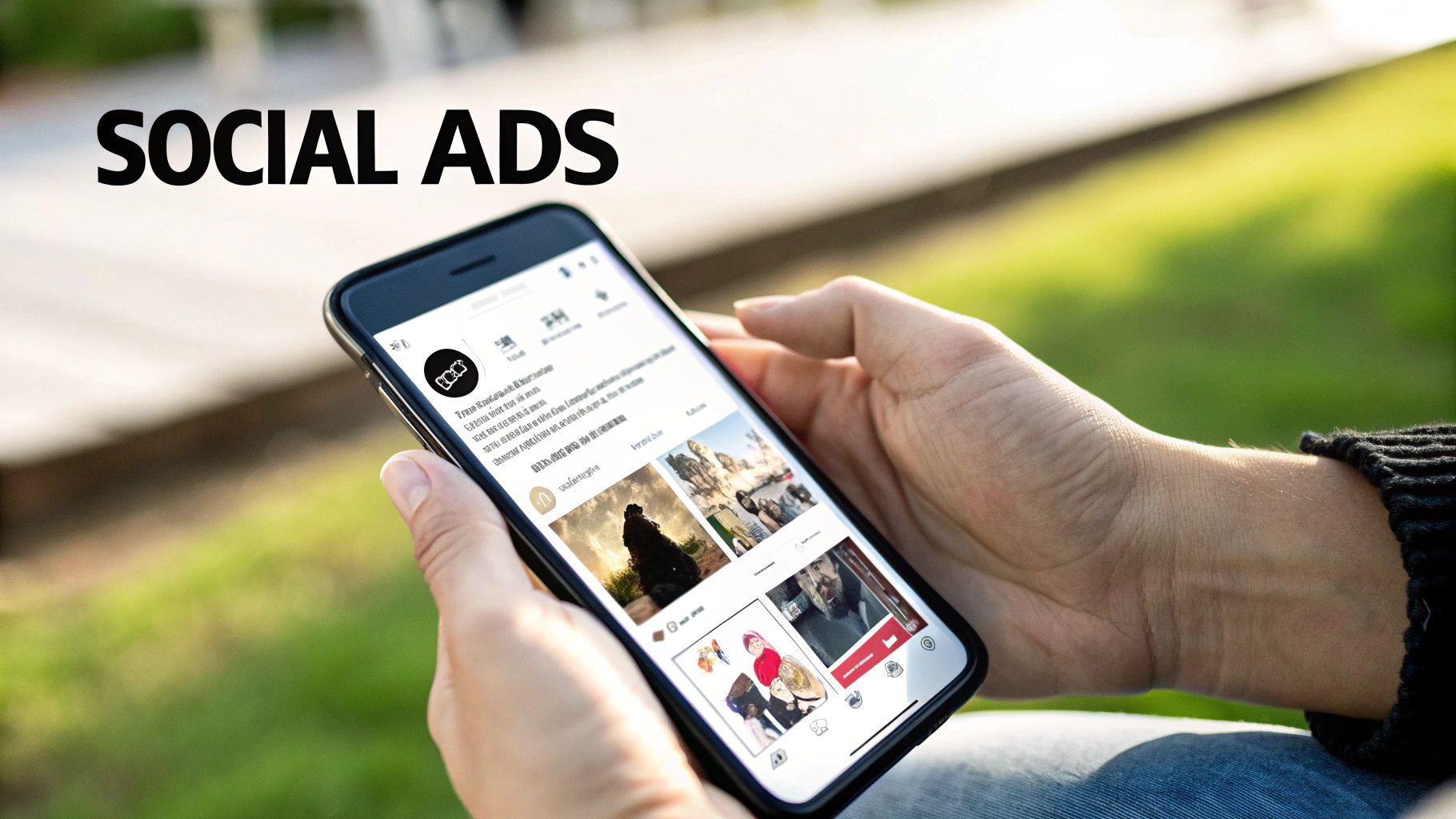
Getting a steady stream of leads is a massive win, but that’s only half the battle. The real challenge—and where most agencies drop the ball—is actually managing and nurturing those leads so they don't go cold. A lead that you never follow up with is a completely wasted opportunity, which is why building an automated management system is non-negotiable if you want to scale.
This isn’t just about having a CRM. It's about creating a connected ecosystem where every lead is tracked, scored, and nurtured with precision from the moment they enter your pipeline. The goal here is to build a predictable revenue engine that pretty much runs on its own.
Unify Your Pipeline with a Central Hub
First thing's first: you need to eliminate data silos. Your leads can come from anywhere—a LinkedIn ad, a webinar sign-up, a contact form on your site. If this information is scattered across different spreadsheets or platforms, you have zero clarity on your pipeline, and follow-up becomes a chaotic mess.
Your mission is to connect every single lead source directly into your CRM. This creates a single source of truth, giving you an immediate, unified view of every prospect and their journey. Tools like LeadSavvy Pro are perfect for this, as they can seamlessly sync leads from platforms like Facebook directly into your system, so nothing ever falls through the cracks.
The speed of your response dramatically impacts your success. You are 21 times more likely to qualify a lead if you respond within five minutes versus waiting just 30 minutes. Automation makes this speed possible.
This instant connection is crucial. It ensures your team can follow up the second a lead comes in—when they're hottest—dramatically boosting your chances of booking that first meeting and closing the deal.
Develop Automated Nurture Sequences
Let's be real: not every lead is ready to sign a contract today. Most need a little time and education to build trust in your agency’s expertise. This is where automated email nurture sequences come into play, acting as your tireless 24/7 sales assistant.
Instead of sending out generic, boring follow-ups, build sequences tailored to the lead’s original point of interest.
- Did they download an SEO checklist? Send them a sequence of emails with a killer SEO case study, a link to a relevant blog post, and finally, an offer for a free website audit.
- Did they attend your PPC webinar? Nurture them with a recording of the event, a quick guide on avoiding common ad spend mistakes, and an invitation to a no-pressure strategy call.
These automated workflows keep your agency top-of-mind by consistently providing value. They gently guide prospects toward a sales conversation without you having to lift a finger. For a deeper dive, check out our guide on creating a system for automated lead generation that actually converts.
Implement a Simple Lead Scoring Model
As your pipeline grows, your sales team needs to know where to focus their energy. Lead scoring is the system that automatically flags the most engaged, sales-ready prospects for immediate attention.
You don’t need some crazy, complicated algorithm to get started. A simple point system based on key signals works wonders:
- High-Value Actions: Award more points for actions that show strong intent, like visiting your pricing page (+10 points) or requesting a demo (+25 points).
- Engagement: Assign points for simpler actions like email opens (+1 point) and clicks (+3 points).
- Demographics: Give points if a lead perfectly matches your Ideal Client Profile, like company size or job title (+5 points).
Once a lead reaches a certain threshold—say, 50 points—your CRM can automatically create a task for a salesperson to reach out personally. This data-driven approach ensures you prioritize the hottest leads, stop opportunities from going cold, and build a truly efficient sales machine.
Common Questions About Agency Lead Generation
Look, I get it. Trying to nail down a solid lead generation plan for your agency opens up a can of worms. You're juggling everything from "How much should I even spend on this?" to "Why is my pipeline a ghost town this month?"
Let's cut through the noise and tackle the big questions I hear from agency owners all the time.
How Much Should We Really Budget for Leads?
This is always the first question, and for good reason. There’s no magic number, but here’s a benchmark that works: set aside 10-15% of your desired revenue for all your marketing and sales activities.
So, if your agency is aiming for $500k in annual revenue, you should be investing somewhere between $50k and $75k back into your growth.
That budget covers everything—your ad spend, content creation, software subscriptions, the whole lot. Think of it less as an expense and more as fuel for your agency's engine.
Which Strategy Gets Me Clients the Fastest?
When you need to sign clients now, you don't have six months to wait for SEO to kick in. While long-term plays like content and SEO are fantastic for sustainable growth, they're a slow burn.
If you're looking for quick wins, two channels consistently deliver:
- High-Intent Paid Ads: Go straight for the jugular. Bidding on keywords like "PPC agency for e-commerce" gets you in front of people who are actively shopping for your exact service.
- Personalized Outbound: A super-targeted LinkedIn campaign aimed at your Ideal Client Profile can book you meetings in weeks, not months. Forget generic spam—I'm talking about genuine, personalized outreach.
The real secret is finding a balance. Use short-term tactics to keep the lights on today while you build the long-term inbound machine that will feed your agency for years.
How Do I Stop the Feast-or-Famine Cycle?
One month you're drowning in leads, the next it's crickets. Sound familiar? This rollercoaster ride is almost always a sign that you're relying on just one or two lead sources. It’s a classic mistake.
The fix is diversification. You need a system with multiple channels working in harmony.
When referrals slow down, your SEO content is still bringing in traffic. If a paid campaign suddenly stops performing, your cold email sequence is still warming up prospects.
This multi-channel approach is what separates a reliable business process from a series of disjointed campaigns. It turns lead generation for a marketing agency into a predictable system. For a deeper dive on building this out, our complete guide on lead generation strategies for marketing agencies breaks it all down.
Tired of the daily grind of downloading Facebook leads? LeadSavvy Pro syncs them straight to your Google Sheet or CRM in real-time. That means you can follow up in minutes, while the lead is still hot. Give LeadSavvy Pro a try for free!

